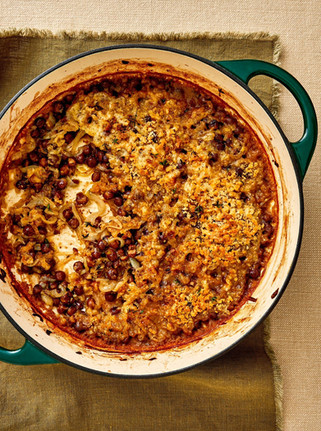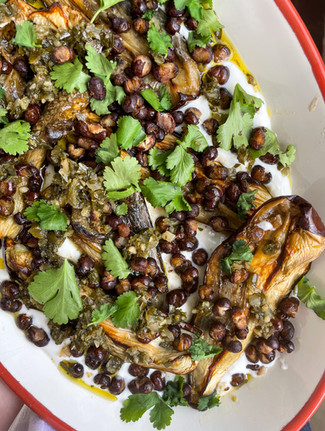THE BRITISH BEAN THAT SHAPED BOLD BEAN CO’S JOURNEY - AMELIA CHRISTIE-MILLER
- SSAW Collective
- Mar 20, 2024
- 7 min read
I put down the phone with a smile on my face - and trust me, that’s not a common occurrence for someone in sales - particularly if they sell to overworked chefs living within the M25. My job was to connect farmers and producers to London’s top restaurants - a matchmaker - connecting everything from mushroom foragers and mangalitza farmers to the very best hospitality ventures in London - (the trendy neighbourhood small-plate spots and the white-tableclothed Mayfair institutions). These were the only chefs that could justify the time and budget spent on sourcing rare breed meat and locally grown lettuce, however that “time” they could afford was rarely 5 minutes a week, and they get called by 20 “Amelia’s flogging food” - so make the most of the fact they even answer the phone to you.

Photo credits: Milly Fletcher
Any good salesperson will know, don’t waste time pitching the low value items. Get them onto the truffle hunters, caviar makers and day-boat fishermen, don’t faff around with cheap ingredients ordered in small quantities. And of course I knew this, but I still couldn’t help myself - once again rather flogging the prized turbot from Devon i’d chosen to put my energy into selling a meagre bag of British-grown pulses called Carlin Peas - Hodmedod’s (the producer) were going on Henry’s menu and I was elated.
I got up from my kitchen table and decided to make myself a coffee as a reward. I flung open the cupboard and reached for the coffee beans, but I paused mid way; I had spotted the very same bag of British-grown Carlin Peas I’d just been waxing lyrical to Henry about. They had been there for over three months, gathering dust. How was it that an ingredient I had forgone a bonus for, that I believed in to my very core, I still hadn’t got around to cooking and actually eating myself? This was one of those defining moments that would begin me on my journey into creating a brand on a mission to make you obsessed with beans, a brand called Bold Bean Co.

So how had the carlin pea, a bean that you probably haven’t even heard of, made such an impression on me? Why was it so important? For me, it started (like most life on this planet) with the soil. As you reading this journal will likely know, our soils are in a dire condition - industrial farming methods have left them depleted and heavily reliant on chemical nitrates that only further exacerbate the problem. But it's not hopeless at all - Nature has a delicious, nourishing, longevity-giving fix for this - we can plant crops that naturally fertilise the soil (taking nitrates from the air, and fixing it into the soil) - and those crops are legumes. This is not a groundbreaking scientific discovery but a method humans have been using since the beginning of civilisation - bean crops were the world's first fertiliser and they have continued to be used by British farmers for this very reason. These incredible crops work their restorative magic underground and simultaneously create nutritious, delicious beans for humans to eat. Given Carlin Peas are low in fat, high in protein and fibre (with at least 23g per 100g of both) and packed with other vitamins and minerals, it’s a miracle we aren’t all eating them daily.
But we used to. Carlin Peas as an example, petered out of popularity as soon as battery farmed animal-based protein sources became readily available. It’s rep as “the poor man’s meat” meant eating beans was a symbol of shame and poverty and our meat-two-veg dinners couldn't get away from them fast enough. So with little demand, farmers have been forced to feed these protein-packed marvels to the pigs, (literally to livestock). If this solution to our soil crisis is only ever seen as a byproduct - what hope do we have of encouraging more farmers to begin growing it?
We need demand for these regenerative crops - it was Josiah and Nick of Hodmedod’s that first saw this need and they’d fully recruited me as a groupie, just a time-poor twenty-something one who shopped in Sainsbury’s local and didn’t listen to the band’s top track: the carlin pea.
So I stared at the cupboard with a nearly empty bag of coffee beans but a full bag of Carlin peas and dissected. I blamed it on being too busy. Prioritising drinks with friends and brunches over cooking up a pot of beans in a tiny Brixton flatshare. Eating these needed to be easy for someone like me to change my habits. And (embarrassingly given previous work as a private chef), I felt uninspired on what to do with them. They weren’t on my food-ridden instagram feed nor my cookbooks, but crucially I - as someone who backed myself in the kitchen - struggled to put them into weekly meals rota.

I sat on the table and dreamt up a food brand that would make this nutty, delicious bean easier to fit into peoples mealtimes. Would I simmer them into a stew and rival Charlie Bigham? Would I blitz them into a dip and have them served with pop chips? A quick bit of research led me to see that us Brit’s weren’t even excited about the well-known beans, let alone the British ones. I needed to create a brand first that made people get excited about beans - and only then seduce them with the British ones.
After all, it was that personal experience that led me to my own bean obsession - the turning point was during my University exchange in Madrid - where I first tried an heirloom butter bean (by eating one straight from the jar). Years of then seeing beans on restaurant menus and using them in my cooking to create uncompromising veggie meals meant that I was already hooked on beans from a meat-reduction perspective, and then far more excited about the British varieties when I discovered them and their role in soil health and food security. .

So I started with the main barriers to bean-eating, quality and use-case. I began working away at getting the very best beans and started an instagram sharing inspiring bean recipes to help inspire people on how to cook them. Fast-forward nearly three years and we’ve built up a community of the bean obsessed, launched a cookbook dedicated to bean recipes and somehow got our jars of expertly-sourced beans on the shelves of Sainsbury’s, Waitrose and M&S.
I’ve had many milestones on the Bold Bean Co journey but, this year, when I saw a jar of our Carlin peas in Waitrose stores for the first time - it really was a full-circle moment. I was back in that tiny Brixton kitchen, staring at those dried beans in the cupboard - but this time, with a solution. People have called this national retailer launch “innovation”, but it's not, its restoration. Bringing back a bean that has been (and hasn’t stopped) growing on British soil since the Elizabethan era and re-establishing it in our food culture.

Carlin’s are also known as maple peas or black badgers, they have a firm texture and a nutty flavour reminiscent of chestnuts. A huge part of what made my initial beans stick in people's routines was through the recipe inspiration, so a huge part of making this work was in sharing the myriad ways you can use this bean.
If you google this variety, you’ll likely come across the Lancashan dish "parched peas" (a recipe for cooking them with butter and vinegar). Here they are still annually served up in paper cones as a street food snack on bonfire night. In recent years, food writers like Anna Jones, Tom Hunt and Gizzi Erskine have published books featuring Carlin Pea recipes and Wahaca restaurant has even put them into the “Sonoran hummus” on their menu. Even since the launch of our Hodmedod’s collaboration - with nutty, creamy carlin peas cooked to perfection in the Bold Bean Co way, I’ve seen some of my favourite chefs get incredibly creative with them. Sophie Wyburd has crafted a curry leaf and carlin fritter that fully embraces their slightly rough skin by letting it crisp and crunch and Michael Davies of The Camberwell Arms uses them in a fagioli e tonno recipe. We may be well away from these beans being popular, but I think we’ve made a start, and I’m beyond excited to see where these underrated marvels go.
RECIPE

Carlin Peas On Toast With Swiss Chard, Garlic, Chilli & Goat's curd (or ricotta)
Serves 6-8 as a canapé
This is a wonderful snack to start a meal, grilling the toast over coals for your first spring BBQ would be a great place to begin! Or, if that’s not on the agenda it’s equally as well suited for a lunch - it’s quick to throw together, full of colour, nutrients and flavour. We love using Two Fields Olive Oil which has a great peppery kick , as well as being a highly respectable regenerative farming operation!
Ingredients:
1 bunch of Swiss chard, stalks removed from the leaves
1 garlic clove, finely sliced
1/2 tsp smoked chilli flakes
A few generous glugs of extra virgin olive oil
Carlin peas, 3 heaped tablespoons (including juices)
Sourdough, thinly sliced and toasted
Goat's curd (or ricotta)
Black pepper and salt
Method:
Cut the chard stalks into approx 1cm pieces. Using your knife roughly shred the chard leaves, so that you’re left with 5cm widths. Blanch the stalks in salted boiling water for 5 minutes, then add the leaves to the pot and cook for another 2.
Drain the chard and rinse under cold water, when cool enough to handle squeeze out all of the excess liquid. It's important to give the leaves a really good squeeze!!
Return the same pan to the heat, add a generous glug of olive oil, set the flame to low, add the sliced garlic, let that sizzle for a minute, before adding the chilli flakes, stir and cook for a minute before adding the blanched chard. Mix well with a wooden spoon, making sure the chard is nicely coated in oil, set the heat to low and cook gently for 5 minutes. Next add the carlin peas, stir well and allow the flavours to mingle for a few minutes over a low flame.
Meanwhile, toast or grill your bread. Slather the curd over the hot toast. Check the seasoning of the pea mix, and using a tablespoon guide the topping onto the toast. Cut into whatever size is most appropriate!
Discover More
Bold Bean Co’s Queen Carlin Peas are available in Waitrose stores and through their website.






Comments